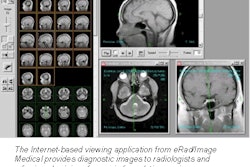International image-viewing quality standards are long overdue, says a recent article in the British Journal of Radiology.
Just as imaging is central to healthcare, image quality is the heart of accurate diagnosis, wrote authors Kwan Hoong Ng, Ph.D., Dr. Basri Abdullah, and colleagues from the University of Malaya Medical Center in Kuala Lumpur (BJR, August 2001, Vol.74:883, pp. 675-676).
Studies show that both the luminance of display devices and ambient viewing conditions have a direct effect on diagnostic quality.
"Extensive psychophysical and clinical research has established the fact that lesion detectability declines when viewing conditions are not optimized," the authors wrote. "Sad to say, the viewing of radiographic images ... is not accorded much importance and the radiology community has given it scant attention."
Part of the problem is the sheer complexity of image viewing. Abdullah and Ng referred to an article in the Journal of Digital Imaging, in which the contrast-detail characteristics of several display devices were evaluated under various gamma and display settings (May 2000, Vol.132, Supplement 1, pp. 162-167).
In a study that showed low interobserver and intraobserver variance, authors Jihong Wang and Jon Anderson found that extraneous light, such as room lighting, affects the contrast threshold more severely at low rather than high background levels. In addition, gamma settings on graphics adapters are extremely important, affecting the shapes of the contrast-detail curve for all display types.
Among the salient findings, gamma settings of approximately 2.0 improved contrast thresholds for both high and low background brightness levels, Jihong and colleagues wrote. Among digital viewing options, digital projector displays not only performed significantly worse than CRT monitors, they were found to be more seriously affected by extraneous light.
"High-brightness monitors with optimal monitor and graphics settings have better performance than color or low-brightness monitors," the study stated. "However, under some settings, the performance of high-brightness monitors is not always better at all object sizes and background levels.... We think the problem is probably due to the limited number of gray steps the graphics adapter can display."
A common problem is that identical monitors can look different on different workstations, according to the Journal of Digital Imaging study.
"This may well be due to the difference in graphics adapter[s] on these workstations, or the gamma settings of the monitor itself. One needs access to a LUT [lookup table] adjustment mechanism to be able to match the 'looks' of these monitors," the authors wrote.
At higher gamma settings, the higher end of the LUT is extended, allowing better visualization of brighter areas. However, because there is a lower limit to luminance levels, higher gamma settings lead to loss of image quality in darker areas, Jihong and colleagues concluded.
In the BJR article, Abdullah and Ng noted that there have been attempts to establish viewing standards and guidelines. Both the Royal College of Radiologists and the American College of Radiology (ACR) recommend monitor luminance of at least 171.3 cdm-2 (50 ft-L). Yet the ACR does not offer specific guidelines for room lighting, merely suggesting that "care should be taken to control lighting in the reading room to eliminate reflections in the monitor and to lower the ambient light as much as feasible," they wrote in reference to the ACR's 1998 Standards for Teleradiology.
Abdullah and Ng wrote that the most comprehensive guidelines on viewing conditions were developed jointly by the ACR and the American Cancer Society. The guidelines recommend mammography view-box luminance of at least 3,000 to 3,500 cdm-2 and room ambient illumination of 50 lux or less (1999, ACR mammography quality control standards).
Meanwhile, digital film viewer firm SmartLight of Yokneam Elit, Israel, has published a comprehensive list of international quality regulations for radiographic film reading on its Web site, the authors wrote, noting that despite the growing popularity of PACS, the vast majority of facilities worldwide still rely on view boxes to display and read films.
In the realm of soft-copy viewing, the authors cited a 2000 study, led by Dr. Eliot Siegel, at the VA Medical Center in Baltimore. The study found that lighting and ergonomics have an important impact on the radiologist's comfort, speed, and accuracy in soft-copy interpretation (Journal of Digital Imaging, May 2000; Vol. 13:2, Supplement 1, pp. 22-23.)
"There appears to be unanimous agreement in support of the view that low levels of room illuminance are necessary for optimal viewing conditions," Abdullah and Ng wrote. "A few studies have demonstrated that [display device] luminance does not have much influence on detection and subsequent diagnosis. More research is needed to confirm this finding."
Abdullah and Ng recommended several steps to focus international efforts on image quality, such as the:
- Establishment of international standards and guidelines for display device luminance and ambient illuminance;
- Standardization of luminance measurements and terms to replace the multiplicity of terms such as cdm-2, nit, and ft-L, and the establishment of calibration facilities for luminance meters;
- Establishment of protocols for performance evaluation and routine quality control of display devices;
- Encouragement and financial support of psychophysical research on soft-copy reporting;
- Teaching of image viewing principles to radiology, radiography, and medical physics students;
- Creation of guidelines for designing reading rooms that incorporate display boxes, monitors, or hybrid devices.
AuntMinnie.com staff writer
September 6, 2001
Join our forum on PACS workstation image quality Sept. 4-7 in AuntMinnie.com's PACS Digital Community. To post a question or comment on this topic, please visit our forum here.
Related Reading
Image quality is still job one for PACS, August 31, 2001
Soft-copy review of CT studies bolsters productivity, April 26, 2001
Task, lesion type make a difference in digital mammography display, August 31, 2000
Baltimore VA survey says human factors count in soft-copy reading, August 29, 2000
Copyright © 2001 AuntMinnie.com


















